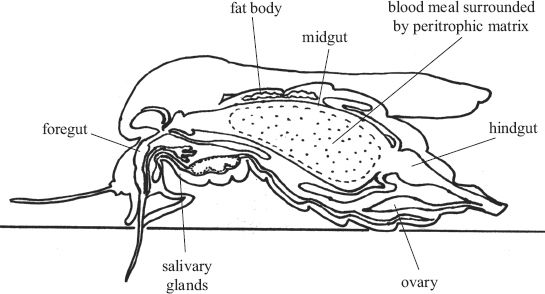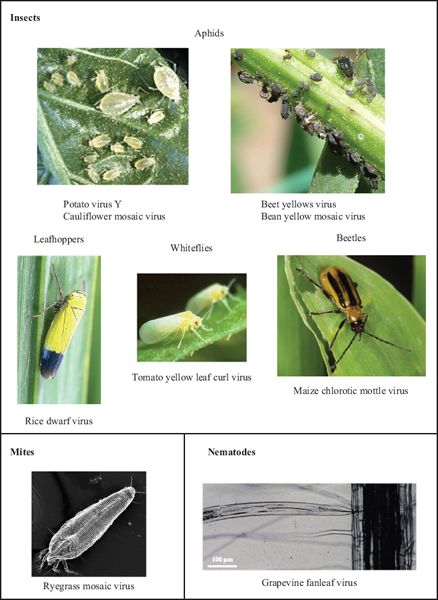4.1 INTRODUCTION TO VIRUS TRANSMISSION
A minimum proportion of the virions produced in infected hosts must be transmitted to new hosts in which more virions can be manufactured. If this does not happen the virus will die out. The only other possibility for the survival of virus genes is for them to be maintained in cells as nucleic acids, which are replicated and passed on to daughter cells when the cells divide.
Viruses of bacteria and other microbial hosts are released from infected cells into the environment of the host, where further susceptible cells are likely to be present. These viruses are dependent upon chance encounters with susceptible cells, to which they may bind if receptors on the surface of those cells come into contact with virus attachment sites.
Viruses of multicellular animals and plants must also find new cells to infect. An infection may spread to adjacent cells, or to cells in a distant part of the host after transport in the blood of an animal or in the phloem of a plant, but ultimately a virus must find new hosts to infect if it is to survive.
Some virus infections modify the behavior of their hosts in order to increase the probability of transmission. Mammals infected with rabies virus often become aggressive; this change in behavior increases the likelihood of the host biting another individual and transmitting virus in the saliva. Some plant-feeding insect larvae infected with baculoviruses become more mobile in the late stages of infection, thus aiding virus dispersal. If the virus-infected insect migrates toward the top of a plant, then lower leaves, where other larvae will feed, will become contaminated when the host dies and putrefies.
On their journeys between hosts, viruses may have to survive adverse conditions in an environment such as air, water, or soil; the survival of virus infectivity outside the host is discussed in Chapter 24. There are some viruses, however, that can be transmitted to new hosts without “seeing the light of day,” in other words without exposure to the outside environment. These are viruses that can be transmitted directly from host to host, for example during kissing or sexual intercourse, and viruses that are transmitted via vectors. Also included in this category are viruses that can be transmitted directly from a parent to members of the next generation. Transmission in these cases is said to be vertical; otherwise it is described as horizontal.
Viruses may be moved over long distances in a variety of ways. Rivers and winds can move viruses to new areas. The foot and mouth disease outbreak on the Isle of Wight, UK, in 1981 was initiated by virus that had spread via the air from Brittany, more than 250 km away. Viruses of birds, fishes, humans, and other hosts are transported within their hosts to other parts of the planet as a result of migration, travel, and animal export, for example:
- bird migration (avian influenza viruses);
- human travel (SARS coronavirus);
- animal export (monkeypox virus).
Furthermore, viruses can be transported on inanimate materials; for example, foot and mouth disease virus on straw and farm vehicles.
Once virions have entered a multicellular organism they may have further to travel before suitable host cells are encountered. During this final stage of their journey the virions will encounter hazards in the form of host defense mechanisms, which must be survived if the virions are to remain infective when they reach their destination.
In theory, a single virion can initiate an infection, but in practice it is often found that a host must be inoculated with a minimum number of virions in order for that host to become infected. The reasons for this are probably many and varied, and may include some virions being defective and some being inactivated by the host’s immune systems. This minimum amount of virus required for infection of a host is known as the minimum infective dose.
In this chapter we shall look at the ways that viruses of plants and animals are transmitted from host to host, but first we must look at some general aspects of virus transmission by vectors.
4.1.1 Transmission via vectors: general principles
Many viruses of plants and animals are transmitted between hosts by organisms that feed on them; these organisms act as vectors. There are several concepts concerning vector transmission that are common to viruses of both plants and animals so, before discussing these host categories separately, it is useful to consider these concepts.
Most vectors of viruses are arthropods (insects, mites, ticks); the arthropod-transmitted viruses of vertebrates are sometimes referred to as arboviruses (arthropod-borne viruses).
The principle of vector transmission is that the vector acquires a virus when it feeds on an infected host and subsequently transmits the virus to one or more new hosts. Some viruses are transmitted after virions have become attached to the mouthparts of their vectors during feeding. Transmission in this way may occur within seconds or minutes of the vector acquiring the virus. Many vector-transmitted viruses, however, cross the gut wall of the vector and enter its circulatory system. The virus ultimately reaches the salivary glands and is secreted into the saliva, which may transport virus into new hosts when the vector feeds. This mode of transmission is said to be circulative, and transmission does not occur until hours or days after the vector has acquired the virus.
Some circulative viruses replicate in one or more tissues and organs of their vectors (Figure 4.1); thus there are many viruses that can replicate in both invertebrates and vertebrates, and a few viruses that can replicate in both invertebrates and plants. It is fascinating to contemplate the existence of viruses with such broad host ranges. Many (but not all) of the invertebrates appear to suffer little or no harm when they are infected, so it has been hypothesized that some modern “vertebrate viruses” and “plant viruses” are descended from viruses of invertebrates that later extended their host ranges to vertebrates or plants.
Figure 4.1 Cross-section of a mosquito. Some of the organs and tissues that may become infected by a virus acquired in a blood meal are indicated.
Source: Higgs (2004) Chapter 7, 63rd Symposium of the Society for General Microbiology, Cambridge University Press, by permission of the author and the Society for General Microbiology.

If the reproductive organs of the vector are infected there may be possibilities for vector-to-vector transmission. Some viruses are sexually transmitted (male to female and vice versa) and some are transmitted to the next generation within the egg; the latter is known as transovarial transmission.
There is a high degree of specificity between most vectors and the viruses that they transmit. Generally, specificity is greater between plant viruses and their vectors than between vertebrate viruses and their vectors.
4.2 TRANSMISSION OF PLANT VIRUSES
Plant cells are surrounded by thick cell walls that present significant barriers to virus entry; most plant viruses are carried across these barriers by vectors. A wide variety of organisms use plants as sources of nutrition and some of these organisms, especially invertebrates, act as virus vectors (Figure 4.2). Many of the vectors (e.g. aphids, nematodes) feed by piercing cell walls and ingesting the contents, while beetles feed by biting.
Figure 4.2 Examples of invertebrate vectors of plant viruses, and examples of viruses transmitted.
Sources:
• aphids
– left: Myzus persicae, courtesy of Magnus Gammelgaard Nielsen;
– right: Aphis fabae, courtesy of Robert Carter;
• leafhopper (Nephotettix cincticeps), courtesy of Keiji Morishima;
• whitefly (Bemisia tabaci), courtesy of Dr J. K. Brown, University of Arizona;
• beetle (Diabrotica virgifera virgifera), courtesy of Anthony Zukoff;
• mite (Abacarus hystrix), courtesy of Dr Anna Skoracka, A. Mickiewcz University of Poznan;
• nematode (Xiphinema index feeding on a root), from MacFarlane and Robinson (2004) Chapter 11, 63rd Symposium of the Society for General Microbiology, Cambridge University Press, reproduced by permission of the Society for General Microbiology.

Stay updated, free articles. Join our Telegram channel

Full access? Get Clinical Tree


